Every time I interview Ryan K. Lindsay I learn something new, which is why he’s been a repeated guest. As an Australian, he’s continents away from the center of the comic book industry but he continues to find a way to make interesting comics and build his audience. His crowdfunding efforts are particularly impressive because every Kickstarter he runs feels unique from the last. For this chat, we discussed his comic SKYSCRAPER with Mitchell Collins and Simon Robins, an oversized comic printed on newspaper print a la Wednesday comic Ryan is Kickstarting. I asked him about that, advancing to ongoing series, and what excites him as a storyteller.
All art in this post by Mitchell Collins and Simon Robins
How did you come up with the idea to frame each page as a shot of the same building?
This was the first thing I locked down. Which is frustrating because it’s not a story, and it’s definitely not a character arc, but it most definitely is interesting. I don’t remember if anything specifically inspired me, I’m obviously standing on the shoulders of titans from Kirby, McCloud, Ware, Shaun Tan, McEown, and most specifically Richard McGuire’s HERE. I feel like I had this idea/concept and then my intelligent and debonair editor, Dan Hill, linked me to McGuire’s masterpiece, but this whole thing started back in 2014 and my mind is as fuzzy as my inbox search just was.
With the idea set, then I went about concocting a story, which meant not only a story that interested me, but one that could work in this format. It couldn’t be a globetrotting story, it wasn’t going to ever change scenes except for the few rooms we should in the KDP building. But that’s half the fun sometimes, painting yourself into a corner and working out how to lure the radioactive spider in so it can bite you and then you can just crawl the walls outta that corner.
I feel like comics have shown a renewed interest in framing panels on the page in the wake of creators like Tom King. What do you think framing adds to the reading experience?
I feel like the good comics, the real mind-benders, have never stopped with this. David Aja comes to mind as someone who always played with what panels can do, but I’m glad if Tom King’s erudite approach has brought it to the award-winning fore. I think a comic that isn’t playing with panels and gutters and pacing and framing is completely selling itself short. Why not play with those tools? Novels can’t do it, film can’t do it [well]. Your page can be a clear storyboard, or it can be a storytelling experience like no other.
Now, I understand that doing this can muddy clarity, and sometimes if we want things to sell well we might want to retain clarity over all, or we might not want to slow down and gum up the works by demanding so much of the creative team.
But, honestly, you have the ability to melt faces – why would you settle for merely tepidly warming asses?
What appeals to you about publishing SKYSCRAPER on newspaper print?
I knew each page was going to be an event you’d want to lose yourself in, and I didn’t want that scope to be constrained by the standard format of a system that this comic was never going to be aimed for. Allowing the art to breathe is 100% the reason for pushing this model. Plus, I’ve always wanted to make a newspaper sized comic ever since I bought WALK TO JAPAN by Ben Hutchings at a local con years ago, so this was my chance to scratch that itch.
Since they’re fellow Australians, you were able to meet the co-creators of SKYSCRAPER Mitchell Collins and Simon Robins. How did that add to the creative process?
We’d all met previously at cons, and kept in touch, but the making of the comic has been pretty digital, honestly. We all caught up the other weekend at a con and had a nerdy good time, but by then all the pages were inked, and the colours were already rolling in, so it was more a moment to celebrate what we were about to unleash than it was any kind of creative summit.
I swear, I could collaborate with someone in my neighbourhood and it’d still be an all-email affair.
You take steps to make each of your Kickstarters unique. In this case, you’re selling a comic with a unique presentation and visual aesthetic, and you’re theming the reward names around building/construction elements. How important to the success of the Kickstarter is it to individualize each campaign?
I had to think long and hard about this one…I’m not certain it is. I think most comics on Kickstarter offer a similar product, within the scope of things Diamond would normally hold [floppies, trades, etc]. I feel like my campaigns have a fairly similar model – I offer relatively unique upsells, I offer rolling digital stretch goals, and I try to make it fun and a bit of a celebration of the work and the creative team.
I think the story can be new, but people sometimes want to know you’ll offer the same quality you have before. I Kickstarted 3 issues of DEER EDITOR, and each campaign was the same and it just got stronger and stronger in backers and money. I think it’s important to build trust and relationships for and through your campaign, but I think the model can sometimes remain the same, with 10% value add tweaks, and that’s the good stuff. I hope. I actually try to over plan the Kickstarters, but not overthink them, if you know what I mean. It might cost me, but I don’t invest a week in the video, and I don’t have nifty designed placards for illustrating the pledge levels, and I just use a lot more text. I don’t want to be polishing the hubcaps on my car when it’s about to throttle through hell with the windscreen taped black.
I probably am not making sense, sorry.
You’ve written a lot of crime procedurals at this point. What fascinates you about the genre?
I think it’s the broken people in crime stories. Those broken by the world, those breaking the world. I think analysing why people make bad decisions is interesting, and probably helps me better understand the world around me. I also like that crime can go into most other genres – sci-fi, comedy, horror, whatever. Crime is just human fallibility, and from there the meaty character arcs can grow.
Is the decision to write crime procedurals influenced in part because a lot of your work is one-shots?
I hadn’t considered this, but it’s highly possible, yeah. You want a problem, you want a quest/chase, you want a resolution – makes sense to have it centre around a crime.
You’ve never written a comic longer than 5 issues. Are you eager to sink your teeth into an ongoing series at some point?
I’m kind of dying to, yeah. I don’t know if I’m ready for my 60 issue opus – I don’t think the market is ready for those much anymore, but my next step is to drop a 10 issue maxi-series. I’ve got one in the chamber, with a great artist, and we’re just trying to navigate how to get it made. It’s a killer high concept, and the characters absolutely sing, but it’s in a holding pattern, alas.
That said, though, I do dig telling a story and then salting the earth behind me. I enjoy writing conclusions that conclude, not that leave subtle hints at a sequel or more behind. I want to toss the ball up, and then I want to belt it hard enough to split the seam, y’know? So the minis have been really satisfying so far.
Do you have a strategy to make it happen?
Honestly, I thought if I put out enough quality miniseries, I’d progress to a maxi already. It feels like a failure that I haven’t, but then I also love SKYSCRAPER, so I know the number of issues isn’t my metric for success, but rather how damn excited I am about the story.
Beyond that, I can control a little, but the comic making gods will let the rest roll out as it may.
Are there any other avenues of making comics you’re especially excited to explore as a creator?
OGNs, albums, bande dessinee – whatever you want to call them. I want to tell more stories that aren’t beholden to page size or page count, but instead tell the tale as they must, and become beautiful totems for people to hold in their hands. ETERNAL was such a phenomenal comic making experience, and I want to do more of that. And in saying that, keep your eyes open for news about the start of 2020, I have something exciting coming!

Follow Ryan K. Lindsay on Twitter @ryanklindsay and back SKYSCRAPER on Kickstarter for as low as $4.
Matt Chats is an interview series featuring discussions with a creator or player in comics, diving deep into industry, process, and creative topics. Find its author, Matt O’Keefe, on Twitter and Tumblr. Email him with questions, comments, complaints, or whatever else is on your mind at [email protected].












